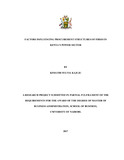| dc.description.abstract | Procurement structures of firms in Kenya’s power sector vary from one firm to another according to their business needs. To attain optimal customer satisfaction firms in Kenya’s power sector have adopted various procurement structures; centralized procurement structures, decentralized procurement structures and hybrid procurement structures. This study set out to determine the factors influencing procurement structures of firms in Kenya’s power sector. Kenya is the fourth largest economy in sub-Saharan Africa with an estimated Gross Domestic Product (GDP) of 55 billion USD (USAID, 2015). According to Omenge (2013) only 35% of Kenya’s population have access to electricity. The study adopted three theories: Game theory as it stipulates a negotiation model; the Social-system theory as it stipulates interrelation between a whole and its sub-systems; the Contingency theory which stipulates there is no single best organizational structure to be adopted. The objectives of this study are to determine the extent of adoption of procurement structures in Kenya’s power sector, to determine factors influencing procurement structures of firms in Kenya’s power sector and to determine the relationship between the identified factors and the adoption of procurement structures of firms in Kenya’s power sector. Data was collected using a descriptive research design with a population consisting of firms in Kenya’s power sector using a census survey. A structured questionnaire was used to collect primary data which was analyzed on SPSS using descriptives, factor analysis and multivariate linear regression. From the study it was found that there are variances in the adoption of procurement structures of firms in Kenya’s power sector. Four factors that influence procurement structures of firms in Kenya’s power sector were identified through factor analysis; organizational factors, operational factors, economic factors and quality. Organizational factors, economic factors and quality were found to have a positive relationship while only operational factors have a negative relationship with a centralized procurement structure. Economic factors, organizational factors and operational factors were found to have a positive relationship while quality has a negative relationship with decentralized procurement structure. Economic factors and operational factors were found to have a positive relationship while organizational factor has a negative relationship with hybrid procurement structure. The four factors showed that they do not have a statistically significant relationship with the adoption of procurement structures of firms in Kenya’s power sector. An examination of the joint relationship confirmed these findings and established that these four variables jointly account for 5.5% of the variability in the adoption of centralized procurement structure, 7.4% of the variability in the adoption of decentralized procurement structure, while 10.1% of the variability in the adoption of hybrid procurement structure of firms in Kenya’s power sector. The firms in Kenya’s power sector are encouraged to embrace procurement structures that best suit their needs | en_US |



